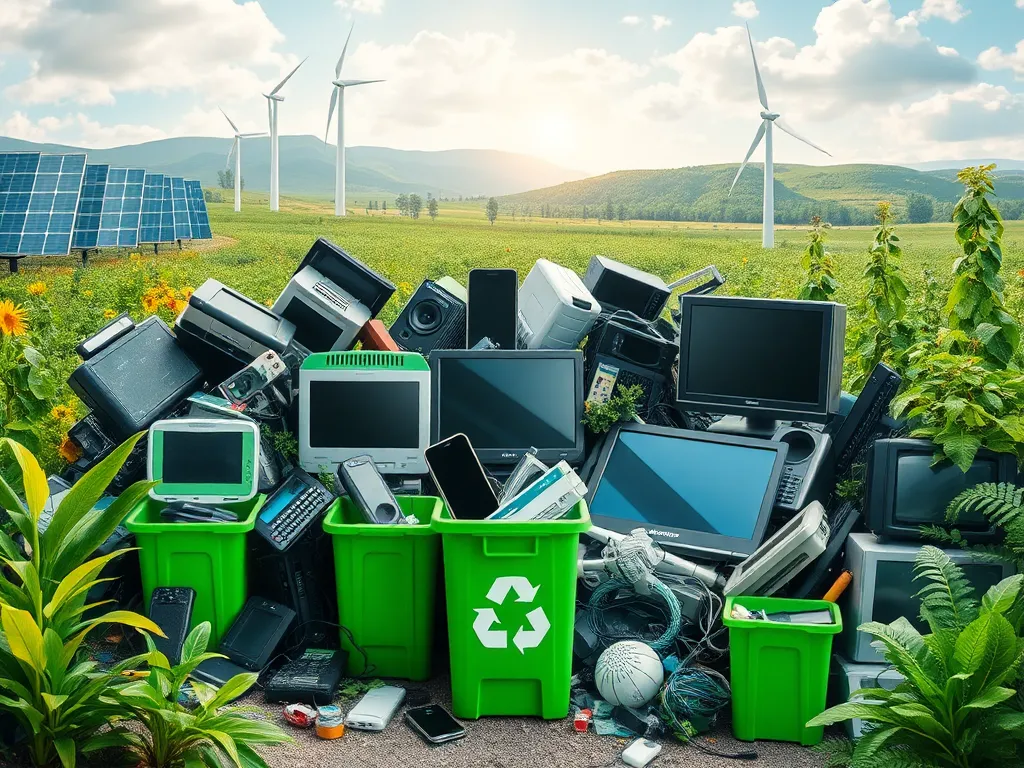Guide to Electronic Waste Disposal and Recycling Tips

Electronic Waste Disposal and Recycling
Electronic waste disposal and recycling is a critical issue in today's technology-driven world. With rapid advancements in electronic devices, the volume of discarded electronics, or e-waste, continues to grow at an alarming rate. Proper electronic waste disposal and recycling are essential to prevent harmful effects on the environment and human health.
This increasing amount of e-waste poses significant challenges, as many electronic devices contain toxic materials such as lead, mercury, and cadmium. These substances can leach into the soil and waterways if not disposed of properly. Therefore, electronic waste disposal and recycling efforts must focus on ensuring that these hazardous materials are managed responsibly.
Recycling electronics helps to recover valuable materials, such as gold, silver, and rare earth metals, which can be reused in the production of new devices. Additionally, electronic waste disposal and recycling create a sustainable loop that minimizes the environmental burden associated with mining for these resources. Overall, promoting responsible practices in electronic waste disposal and recycling is not just a necessity, but a fundamental aspect of a sustainable future.
Many countries and regions are beginning to implement formal regulations and strategies for e-waste management. However, the effectiveness of these measures largely depends on public awareness and participation in electronic waste disposal and recycling programs. Communities, businesses, and individuals must work together to contribute to a healthier planet.
To minimize electronic waste and promote sustainability, consider exploring the benefits of recycling your devices at https://davidsuzuki.org/living-green/recycle-your-electronics/.
In conclusion, electronic waste disposal and recycling are crucial components of modern waste management that need significant attention. The collaborative efforts of individuals, businesses, and governments can lead to innovative solutions for reducing e-waste and encourage a more sustainable approach to electronics consumption.
Importance of Electronic Waste Recycling
The environmental impact of e-waste is profound. Millions of tons of electronic trash are generated each year, and a large portion of it ends up in landfills. When e-waste decomposes, it releases harmful chemicals that can contaminate soil and water supplies, posing a threat to ecosystems and biodiversity. Electronic waste recycling mitigates these risks by ensuring that hazardous materials are disposed of safely and valuable resources are conserved.
Health risks associated with e-waste cannot be overlooked. Exposure to toxic substances found in electronic devices can lead to serious health issues, including respiratory problems, skin diseases, and even neurological damage. Workers handling e-waste in informal sectors are particularly vulnerable, as they often lack protective equipment and knowledge of safety guidelines. By promoting electronic waste recycling, we can reduce these health risks and create safer environments for all.
The economic benefits of recycling electronics are significant. Recycling not only reduces costs associated with waste disposal but also generates revenue through the recovery of valuable materials. Additionally, the e-waste recycling industry has the potential to create thousands of jobs, contributing to local economies. Investing in electronic waste recycling infrastructure can thus lead to sustainable economic growth.
Methods of Electronic Waste Disposal
Safe disposal techniques for e-waste involve several methods, including proper recycling, repair, and refurbishment of devices. Manufacturers can incorporate take-back programs, allowing consumers to return old electronics for recycling or safe disposal. This approach not only ensures that hazardous materials are handled responsibly but also fosters a culture of sustainability.
Centralized e-waste collection points have become increasingly common in public spaces, allowing individuals to drop off unwanted electronics easily. These collection points often collaborate with certified recycling facilities to guarantee that e-waste is processed in an environmentally friendly manner. Community engagement in these initiatives is essential for their success.
Home recycling initiatives encourage individuals to take responsibility for their e-waste. This can include simple actions like donating working electronics, participating in local recycling events, or using mail-in recycling programs. Educating the public about home recycling options plays a crucial role in reducing e-waste and promoting sustainable practices.
Government Regulations on E-Waste
Laws regarding electronic waste disposal vary by region, but many countries have begun to implement stricter regulations to manage e-waste properly. These laws often include requirements for manufacturers to bear responsibility for the entire lifecycle of their products, including disposal. Governments encourage businesses to adopt eco-friendly practices in designing products that are easier to recycle.
E-waste management programs established by governments can provide resources and support for local communities to improve recycling efforts. These programs often include public awareness campaigns, funding for recycling infrastructure, and technical assistance for businesses to comply with regulations. Such initiatives are vital in fostering widespread participation in e-waste disposal and recycling.
Incentives for recycling electronics can include tax breaks for companies that adopt sustainable practices, grants for recycling facilities, and rewards for consumers who recycle their devices properly. These incentives can help to drive more people towards responsible electronic waste disposal and recycling, ultimately leading to reduced e-waste levels.
Best Practices for Businesses
Corporate e-waste recycling strategies should be integrated into a company's sustainability goals. This may involve regularly auditing electronic assets, establishing clear disposal policies, and partnering with certified e-waste recyclers. By taking responsibility for their discarded electronics, businesses can minimize their environmental impact and enhance their corporate reputation.
Tracking electronic assets throughout their lifecycle is essential for effective e-waste management. Businesses should implement inventory systems to monitor the usage and eventual disposal of electronic devices. This data can help companies identify obsolete equipment and plan for its responsible disposal or recycling, thereby reducing e-waste accumulation.
Employee training on e-waste management can optimize a company's recycling efforts. By educating employees on proper disposal methods, workplace policies, and available recycling services, companies can foster a culture of environmental awareness. Training can also empower employees to make informed decisions regarding their electronic devices, reducing e-waste generated within the organization.
Community Recycling Initiatives
Local e-waste collection events provide communities with opportunities to recycle their electronics responsibly. These events often involve partnerships with local organizations and recycling facilities to facilitate on-site collection and safe processing of e-waste. By participating in such events, residents can contribute to reducing e-waste in their communities while promoting awareness.
Partnerships with recycling organizations can enhance community recycling initiatives. Local governments can collaborate with non-profit groups or businesses that specialize in e-waste recycling to maximize resources and expertise. These partnerships can help establish more effective recycling programs and improve overall participation rates.
Awareness campaigns in the community are pivotal in educating the public about the importance of electronic waste disposal and recycling. These campaigns can take on various forms, such as workshops, informational flyers, and social media outreach to engage residents. By raising awareness, communities can inspire individuals to adopt sustainable practices that benefit both the environment and public health.
